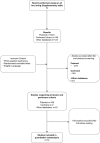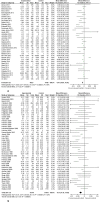Effectiveness of educational and lifestyle interventions to prevent paediatric obesity: systematic review and meta-analyses of randomized and non-randomized controlled trials
- PMID: 29071100
- PMCID: PMC5649699
- DOI: 10.1002/osp4.111
Effectiveness of educational and lifestyle interventions to prevent paediatric obesity: systematic review and meta-analyses of randomized and non-randomized controlled trials
Abstract
Objective: This review and meta-analysis aim at updating a previous meta-analysis carried out by Waters et al. on the efficacy of interventions aimed at preventing childhood obesity and at identifying predictors of outcome.
Methods: Using an ad-hoc search string, PubMed database was searched for studies assessing body mass index reduction associated with programmes lasting ≥12 weeks in overweight and obese children aged 2-18 years. Studies designed for children with eating disorders or relevant comorbidities were excluded. Studies meeting inclusion criteria were classified according to patient age (<6, 6-12 and 13-18 years), and intervention type (physical activity, diet or both), setting (educational, family or both) and duration (≤1 or >1 year). The search was also extended to other databases. Hand-searching techniques were also applied. The Cochrane 'risk of bias' was applied for quality assessment.
Results: Seventy-two studies were meta-analysed. Overall, the best results were achieved by programmes combining diet and physical activity (n = 39). With regard to the setting, programmes involving both school and family and lasting ≤1 year were the most efficacious for 6- to 12-year-old children (n = 26); family-based-only interventions were also effective in children <6 years old (n = 2), although results have to be interpreted cautiously because of the small number of patients enrolled and the high study heterogeneity. In 13- to 18-year-old patients, interventions delivered at school (n = 8) were substantially unsuccessful.
Conclusions: Interventions for childhood obesity prevention should include both diet and physical activity, be preferentially targeted towards school age children and involve both the school and family setting. However, because of the important methodological limitations associated with currently available literature, additional studies are needed to draw definite conclusions.
Keywords: Childhood obesity; diet; educational programmes; physical activity.
Figures







Similar articles
-
The effect of weight management interventions that include a diet component on weight-related outcomes in pregnant and postpartum women: a systematic review protocol.JBI Database System Rev Implement Rep. 2015 Jan;13(1):88-98. doi: 10.11124/jbisrir-2015-1812. JBI Database System Rev Implement Rep. 2015. PMID: 26447010
-
Reducing obesity and related chronic disease risk in children and youth: a synthesis of evidence with 'best practice' recommendations.Obes Rev. 2006 Feb;7 Suppl 1:7-66. doi: 10.1111/j.1467-789X.2006.00242.x. Obes Rev. 2006. PMID: 16371076 Review.
-
Effectiveness of interventions that assist caregivers to support people with dementia living in the community: a systematic review.Int J Evid Based Healthc. 2008 Jun;6(2):137-72. doi: 10.1111/j.1744-1609.2008.00090.x. Int J Evid Based Healthc. 2008. PMID: 21631819
-
Effectiveness of interventions that assist caregivers to support people with dementia living in the community: a systematic review.JBI Libr Syst Rev. 2008;6(13):484-544. doi: 10.11124/01938924-200806130-00001. JBI Libr Syst Rev. 2008. PMID: 27820474
-
School-Based Interventions Targeting Nutrition and Physical Activity, and Body Weight Status of African Children: A Systematic Review.Nutrients. 2019 Dec 30;12(1):95. doi: 10.3390/nu12010095. Nutrients. 2019. PMID: 31905832 Free PMC article.
Cited by
-
Pediatric-Adapted Liking Survey (PALS): A Diet and Activity Screener in Pediatric Care.Nutrients. 2019 Jul 18;11(7):1641. doi: 10.3390/nu11071641. Nutrients. 2019. PMID: 31323759 Free PMC article.
-
Interventions to promote healthy nutrition and lifestyle and to tackle overweight and obesity amongst children in need in Europe: a rapid literature review.Front Nutr. 2025 Jan 7;11:1517736. doi: 10.3389/fnut.2024.1517736. eCollection 2024. Front Nutr. 2025. PMID: 39839302 Free PMC article. Review.
-
[Food environment and excess weight in schoolchildren: a South American systematic reviewAmbiente alimentario y exceso de peso en la población escolar: revisión sistemática en América del Sur].Rev Panam Salud Publica. 2022 Oct 25;46:e164. doi: 10.26633/RPSP.2022.164. eCollection 2022. Rev Panam Salud Publica. 2022. PMID: 36320205 Free PMC article. Portuguese.
-
A Healthy School Start Plus for prevention of childhood overweight and obesity in disadvantaged areas through parental support in the school setting - study protocol for a parallel group cluster randomised trial.BMC Public Health. 2018 Apr 6;18(1):459. doi: 10.1186/s12889-018-5354-4. BMC Public Health. 2018. PMID: 29625599 Free PMC article. Clinical Trial.
-
Effects of Universal School-Based Parental Support for Children's Healthy Diet and Physical Activity-the Healthy School Start Plus Cluster-Randomised Controlled Trial.Prev Sci. 2024 Aug;25(6):963-977. doi: 10.1007/s11121-024-01697-4. Epub 2024 Jul 11. Prev Sci. 2024. PMID: 38987407 Free PMC article. Clinical Trial.
References
-
- Ng M, Fleming T, Robinson M, Thomson B, Graetz N, et al. Global, regional, and national prevalence of overweight and obesity in children and adults during 1980–2013: a systematic analysis for the Global Burden of Disease Study 2013. Lancet 2014; 384: 766–781. https://www.ncbi.nlm.nih.gov/pubmed/?term=24880830. - PMC - PubMed
-
- Lobstein T, Baur L, Uauy R. Obesity in children and young people: a crisis in public health. Obes Rev 2004; 5: 4–85. https://www.ncbi.nlm.nih.gov/pubmed/?term=15096099. - PubMed
-
- Popkin BM, Gordon‐Larsen P. The nutrition transition: worldwide obesity dynamics and their determinants. Int J Obes Relat Metab Disord 2004; 28: S2–S9. https://www.ncbi.nlm.nih.gov/pubmed/?term=15543214. - PubMed
-
- Wang Y. Cross‐national comparison of childhood obesity: the epidemic and the relationship between obesity and socioeconomic status. Int J Epidemiol 2001; 30: 1129–1136. https://www.ncbi.nlm.nih.gov/pubmed/?term=11689534. - PubMed
-
- Wang S, Moss JR, Hiller JE. Applicability and transferability of interventions in evidence‐based public health. Health Promot Int 2006; 21: 76–83. https://www.ncbi.nlm.nih.gov/pubmed/?term=16249192. - PubMed
LinkOut - more resources
Full Text Sources
Other Literature Sources
